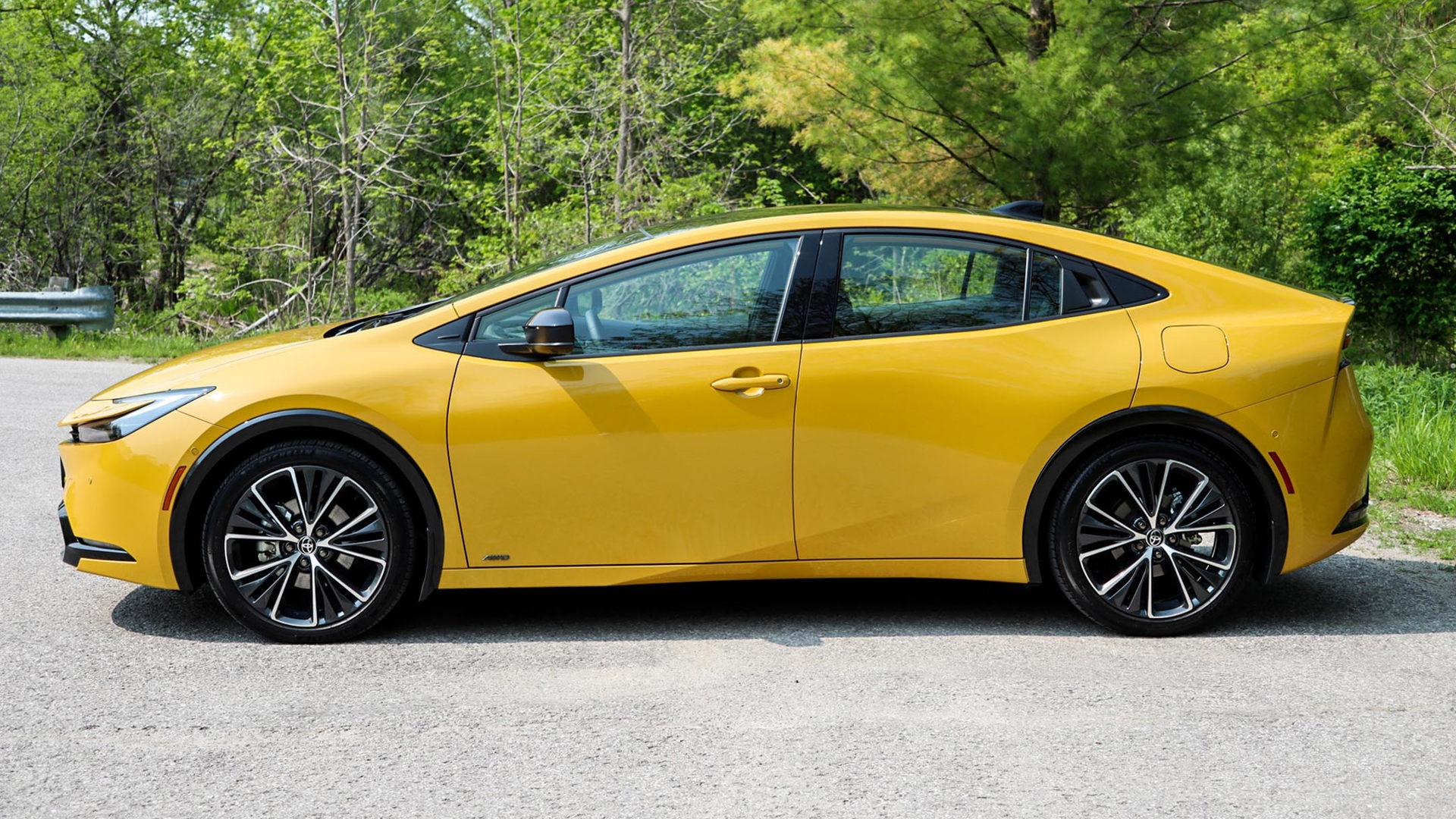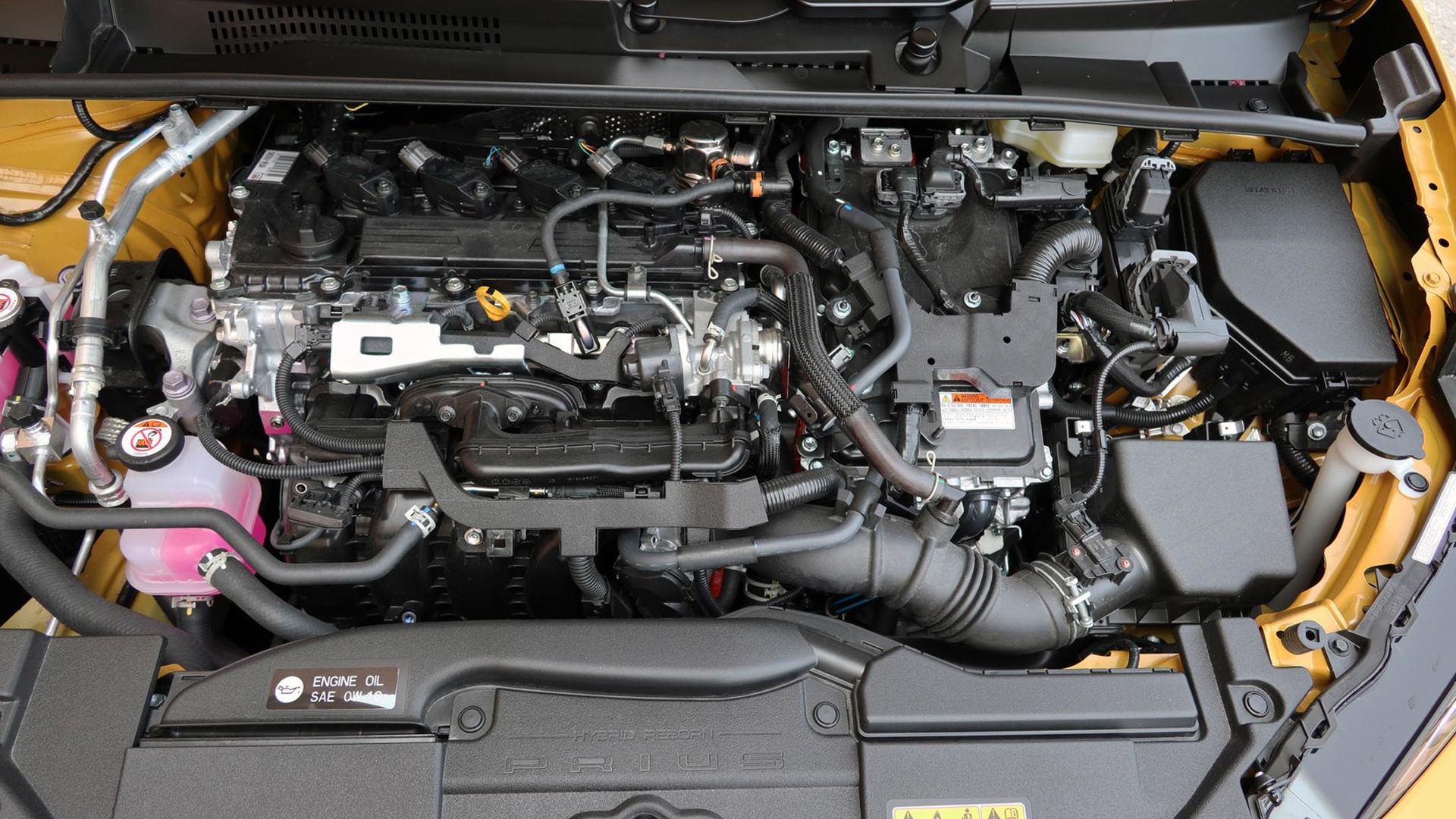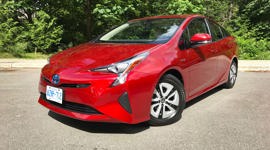 AutoTrader SCORE
AutoTrader SCORE
-
STYLING9/10
-
Safety8/10
-
PRACTICALITY8/10
-
USER-FRIENDLINESS8/10
-
FEATURES8/10
-
POWER8/10
-
COMFORT8/10
-
DRIVING FEEL8/10
-
FUEL ECONOMY9/10
-
VALUE8/10
The 2023 Toyota Prius has been completely overhauled, and if you’ve always thought of it as a frumpy little machine that you bought strictly for fuel economy, think again.
It’s redesigned inside and out, it’s more powerful thanks to a new engine and hybrid system, and it’s a pleasure to drive, with standard all-wheel drive (AWD). It comes in two trims, starting with the XLE at $38,510, including a non-negotiable delivery fee of $1,860. I tested the top Limited trim at $44,850. It’s also available as the Prius Prime plug-in hybrid (PHEV), which comes in three trims that range from $40,010 to $48,850 before tax and government incentives.
Styling: 9/10
The Prius still looks like nothing else on the road, but for the first time in its more than two-decade history that’s a compliment. It’s almost Lamborghini-like up front, while the rear is smoothed out with a full-width taillight bar. The hatch is no longer separated into a rear window and lower glass section, which looks better than before, but it also reduces rearward visibility. The rear door handles are now hidden in the corner of the rear window.
Inside, the previously centre-mounted instrument cluster is now in front of the driver – where it should have been all along. The dash styling is stark but futuristic-looking, especially the unusual squared-off steering column.
Safety: 8.5/10
The new Prius hadn’t been rated by the United States National Highway Traffic Safety Administration (NHTSA), nor the Insurance Institute for Highway Safety (IIHS) at the time of this writing. But standard features include adaptive cruise control, emergency front braking with pedestrian detection, lane-keeping and tracing assist, and automatic high-beam headlights, along with the back-up camera that’s mandatory on all new vehicles.
Some assist features have also been updated from the outgoing Prius. The emergency braking gets improved front detection and can now detect motorcycles, along with pedestrians and cyclists; the lane departure system can detect items such as guard rails, which help it determine where the lane is; the adaptive cruise control has four following-distance settings, up from three; and if you’re unable to steer, such as in a medical emergency, the Prius can slow and stop itself.
Features: 8/10
The Prius comes all-in; the only options are two extra-charge paint shades, and dealer-installed accessories such as door protection mouldings. The XLE includes an eight-inch centre touchscreen, wireless Apple CarPlay and Android Auto, seven USB-C charging ports, automatic climate control, a power driver’s seat, heated front seats in faux leather, a heated steering wheel, rain-sensing wipers, and 19-inch wheels.
The Limited trim further adds a power hatch, wireless phone charger, self-parking system, 12.3-inch centre touchscreen, premium audio, heated rear seats, ventilated front seats, driver’s side memory, a digital rearview mirror, and fixed glass roof. Both trims come with trials to subscription-based connection services including a remote app. Both can use a Google-based connection service including navigation, but it’s available on the XLE, while the Limited includes it for a three-year trial.
User-Friendliness: 8/10
The outgoing Prius’s higher trims offered a vertical centre touchscreen that housed many of the car’s functions, requiring that you take your eyes off the road to search for menus and find the icons – and it washed out if the sun hit it. While I probably can’t take credit – at least not all of it – for the change, the Prius is now back to a far less distracting row of toggles for the climate functions, along with dials for stereo volume and tuning.
The doors open wide and it’s easy to get in and out. Visibility is good out the front, but that sloping rear window cuts down considerably on the view out the back
Practicality: 8/10
The Prius seats five, but they shouldn’t be too tall; the headroom is tight. The cargo compartment has a volume of 575 L, with a storage bin hidden under the cargo floor, and the rear seats fold flat for carrying longer items.
Small-item storage up front is very good, with a horizontal phone holder that doubles as the wireless charger; and a compartment where you can tuck small items away and then stash items on its lid. Both contain some of the Prius’s numerous “Easter eggs” with a couple hashtags moulded right into them.
Comfort: 8/10
The Prius’ front seats are comfortable and supportive, and ventilated in the Limited in addition to the standard seat heating. This trim’s rear chairs are also warmed, as is the steering wheel. The upholstery is soft synthetic leather that feels nice and is easy to clean. The ride is smooth and the cabin is quiet as well. My one request, especially at a price point of more than $40,000, is dual-zone climate control instead of single-zone.
Power: 8.5/10
The Prius uses a 2.0L four-cylinder engine that, on its own, makes 150 hp and 139 lb-ft of torque. It’s mated to twin electric motor-generators, with a combined output of 196 hp. That’s a considerable upgrade from the previous Prius, which used a 1.8L engine and made a combined 121 hp. The extra power is appreciated, especially for highway passing.
As before, it uses an automatic continuously-variable transmission (CVT), which drives the front wheels. Another electric motor powers the rear wheels when AWD is needed for extra traction. The lithium-ion hybrid battery self-charges through regenerative braking and doesn’t get plugged in. Should you want a PHEV, which can be charged to provide a range of battery-only driving, there’s the Prius Prime.
Driving Feel: 8/10
The new Prius has a lower centre of gravity, and wider front and rear tracks than its predecessor, which helps improve handling. The steering is smooth and responsive, and the car tucks in nicely around curves, aided by the rear motor powering those wheels. It’s not a sport sedan, but it feels sportier than the old Prius.
The hybrid system automatically switches between gasoline, electricity, or a combination, depending on driving conditions. There’s an EV button, for electric mode, but don’t expect too much; it keeps the Prius on battery power at low speeds, but the car does that anyway, and a hair too much throttle shuts the mode off. The brakes feel conventional and stop confidently, without the harsh pedal sensation that can sometimes happen with regenerative braking. It can also park itself in this top Limited trim, and while it’s faster to do it yourself, the system works very well and handles everything, including driving ahead to find a spot, shifting into reverse, parking, and then putting itself into park.
Fuel Economy: 9.5/10
The Prius is rated by Natural Resources Canada (NRCan) at 4.8 L/100 km in the city, 4.7 on the highway, and 4.8 in combined driving. I came in a little higher in my week with it, finishing at 5.4. It runs on 87-octane gasoline. That 4.8 L/100 km combined is unchanged from the 2022 Prius, despite being larger and more powerful.
Value: 8/10
At $38,510 and $44,850 for its two trims, the Prius is a little pricey in its small segment of similarly sized hybrid cars. The Hyundai Elantra comes in a single hybrid trim that rings in at $31,074 before tax, while the Toyota Corolla Hybrid ranges from $27,750 for the front-wheel-drive base trim to $36,050 for the range-topping all-wheel-drive version. Meanwhile, the Prius Prime is $40,010 to $48,850 but qualifies for federal, provincial, and territorial incentives.
The Verdict
For its much-better looks, more power, and improved ride and handling, the 2023 Toyota Prius is impressive. It’s not perfect, but it does enough right that it needs to be cross-shopped when you’re in the market. It’s no longer just about fuel efficiency, but that’s just another point in its favour.
| Engine Displacement | 2.0L |
|---|---|
| Engine Cylinders | I4 |
| Peak Horsepower | 150 hp @ 6,000 rpm (engine only), 196 hp (hybrid net) |
| Peak Torque | 139 lb-ft @ 4,400 rpm |
| Fuel Economy | 4.8 / 4.7 / 4.8 L/100 km cty/hwy/cmb |
| Cargo Space | 575 L |
| Model Tested | 2023 Toyota Prius Limited |
| Base Price | $42,990 |
| A/C Tax | $100 |
| Destination Fee | $1,860 |
| Price as Tested | $44,950 |
|
Optional Equipment
None
|
|






















































